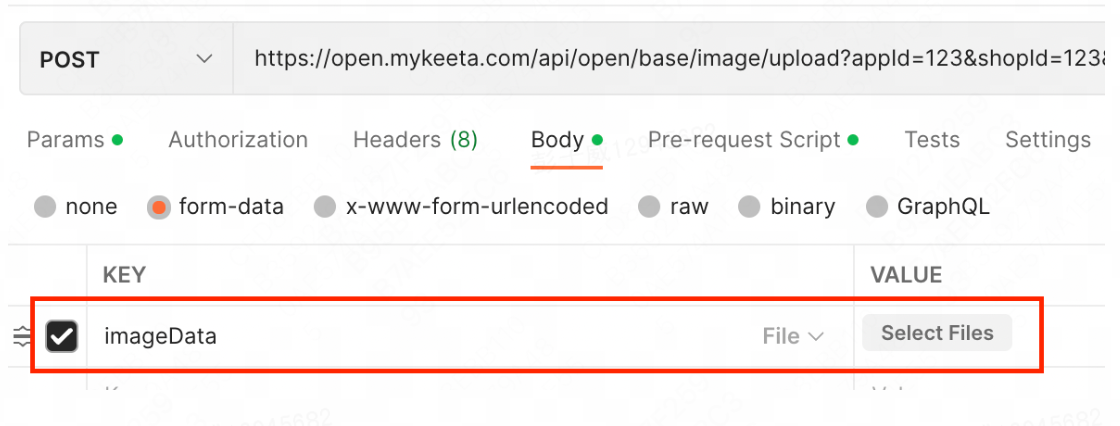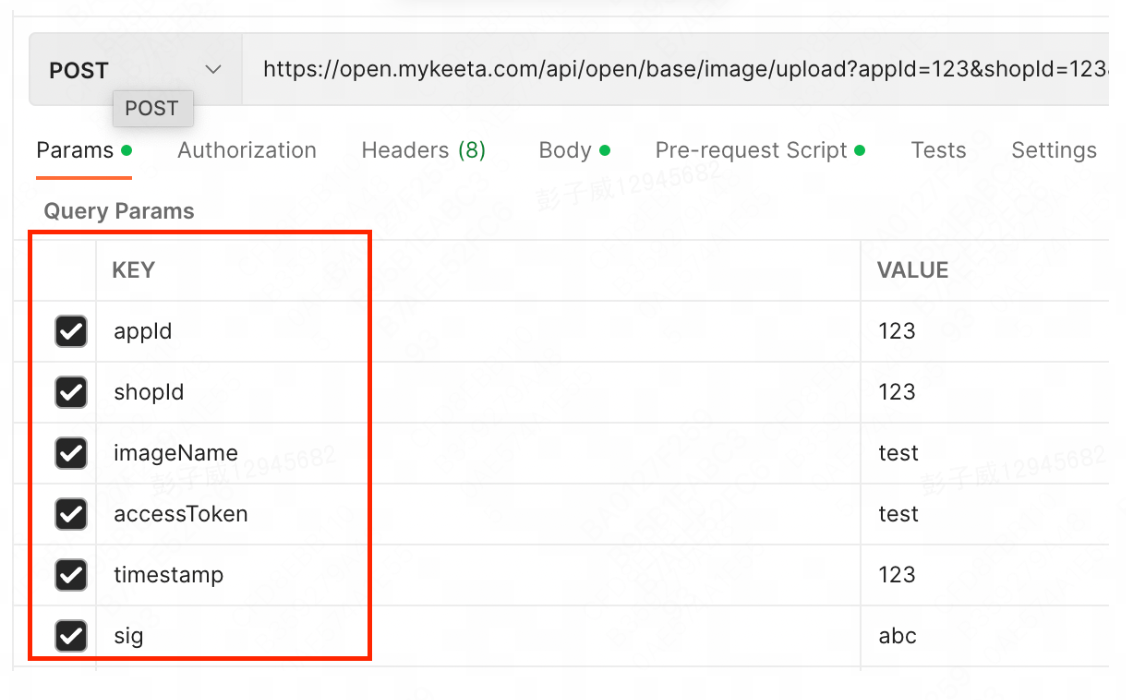When developer send requests to Keeta APIs, the request body must include a signature parameter (field name: sig). Keeta uses this signature to verify request legitimacy and security.
Correspondingly, when Keeta pushes messages (e.g., Webhook notifications) to developer applications, it includes a signature parameter. Developer applications must validate this signature in strict compliance with the signature rules to ensure message authenticity and integrity, preventing tampering or forgery.
Step 1: Parameter Sorting & Concatenation
- Sort all parameters in ASCII order (lexicographical order)
- Concatenate as URL key-value pairs: key1=value1&key2=value2...
Note: JSON parameter values (e.g., shopCategory) require no internal sorting.
Step 2: Construct Encryption String
Concatenate the conponents in this exact order to form the pre-encryption string:
URL + String calculated during Step 1 + AppSecret
Example:
AppSecret = abc
Pre-encryption String = https://open.mykeeta.com/api/open/product/shopcategory/update?accessToken=abc&appId=123&shopCategory={"id":123,"name":"test","type":0,"description":null}&shopId=123×tamp=1682566749abc
Note: Chinese characters require no encoding
Step 3: Generate SHA-256 Signature
Apply SHA-256 encryption to the Step 2 string to get a 64-character signature, e.g. 48eb6d562bb0673e3db753831f032be237fc19d1e5c33fcb5386d89c0eebca86
Note: Empty parameters (defined as parameters with no value) must be included for both parameter concatenation and signature calculation.
Step 4: Add the Signature to Request Parameters
Assign the generated signature to the sig parameter, include sig as a request parameter, and submit the request.
Example (POST request):
curl -X POST https://open.mykeeta.com/api/open/product/shopcategory/update
-H 'Content-Type: application/json'
-d '{
"appId": 123,
"shopId": 123,
"accessToken": "abc",
"shopCategory": {
"id": 123,
"name": "test",
"type": 0,
"description": null
},
"timestamp": "1682566749",
"sig": "48eb6d562bb0673e3db753831f032be237fc19d1e5c33fcb5386d89c0eebca86"
}'//demo
public static void main(String[] args) {
String url = "https://open.mykeeta.com/api/open/product/shopcategory/update";
Map<String, Object> params = new HashMap<>();
params.put("appId", 123);
params.put("timestamp", 1682566749);
params.put("accessToken", "abc");
params.put("shopId", "123");
params.put("shopCategory", "{\"id\":123,\"name\":\"test\",\"type\":0,\"description\":null}");
String sortedParamStr = getSortedParam(params);
String secret = "abc";
String sig = getSig(url, sortedParamStr, secret);
System.out.println("sig:" + sig);
}
public static String getSortedParam(Map params) {
Object[] key_arr = params.keySet().toArray();
Arrays.sort(key_arr);
String str = "";
for (Object key : key_arr) {
if (key.equals("sig")) {
continue;
}
Object val = params.get(key);
str += "&" + key + "=" + val;
}
return str.replaceFirst("&", "");
}
public static String getSig(String url, String sortedParamStr, String appSecret) {
String sigString = digest(url + "?" + sortedParamStr + appSecret);
log.info("getSig(url:{},sortedParamsStr:{}, secret:***},return sig:{})", url,
sortedParamStr, sigString);
return sigString;
}
public static String digest(String src) {
MessageDigest md;
try {
md = MessageDigest.getInstance("SHA-256");
} catch (NoSuchAlgorithmException e) {
throw new RuntimeException("MessageDigest.getInstance(\"SHA-256\") exception", e);
}
return byte2hex(md.digest(src.getBytes(StandardCharsets.UTF_8)));
}
private static String byte2hex(byte[] hash) {
StringBuilder hexString = new StringBuilder(2 * hash.length);
for (int i = 0; i < hash.length; i++) {
String hex = Integer.toHexString(0xff & hash[i]);
if (hex.length() == 1) {
hexString.append('0');
}
hexString.append(hex);
}
return hexString.toString();
}Supported Image Formats: JPG / JPEG / PNG / BMP
Content-Type Requirement: multipart/form-data
Signature Exclusion: The imgData parameter (containing image byte array) must be excluded from signature calculation.
Image-to-Byte Conversion Reference:
public static byte[] image2byte(String path) throws IOException {
FileImageInputStream input = null;
ByteArrayOutputStream output = null;
try {
input = new FileImageInputStream(new File(path));
output = new ByteArrayOutputStream();
byte[] buf = new byte[1024];
int numBytesRead;
while ((numBytesRead = input.read(buf)) != -1) {
output.write(buf, 0, numBytesRead);
}
byte[] bytes = output.toByteArray();
return bytes;
} finally {
if (input != null) {
input.close();
}
if (output != null) {
output.close();
}
}
}Parameter Location Rules: imgData parameter must be placed in the request body. Other parameters must be placed in request parameters.


Yes. All signature parameters must be sorted in ASCII lexicographical order, including:
- All parameters except sig
- Empty parameters (with no value)
- For parameters containing JSON values:
- No internal sorting of JSON fields
- Use the original JSON string as-is
- No additional encoding
Perform step-by-step verification:
- Parameter concatenation order (ASCII sorted)
- Inclusion of empty parameters
- URL/body consistency
- AppSecret correctness
No encoding needed. Use Chinese characters directly in their original form during concatenation.